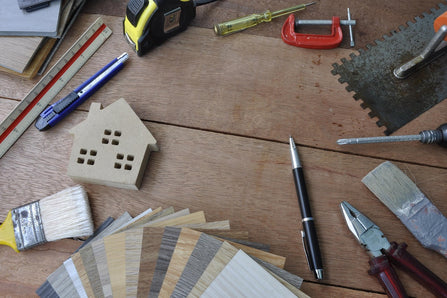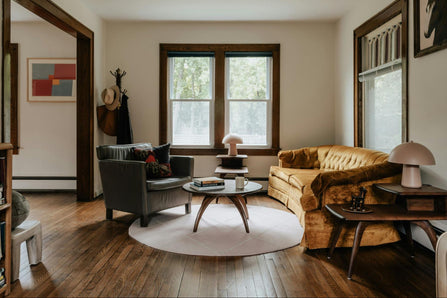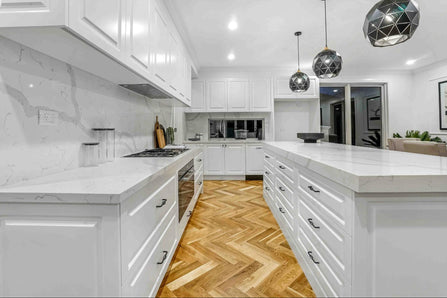Choosing the Best Laminate Underlay for Your UK Home
Posted on by Online Carpets
Although many people associate underlay more commonly with carpets, using underlay for laminate floors is essential to provide a comfortable, level, and long-lasting base. This lightweight layer is sandwiched between your subfloor and your laminate on top, and will help to boost the performance of your floor. From foam to fibreboard, we look at the best underlay for laminate in every room in your home, to help you choose the ideal option before installing your stylish new flooring.
Why Underlay Matters for Laminate Flooring
Underlay is not only key to providing softness underfoot, but it also helps to support laminate boards, provide an additional layer of sound and heat insulation, guard against moisture, and help protect your panels from any imperfections on the subfloor underneath. The best underlay for laminate flooring can vary depending on usage and the moisture levels of each room, but overall it can help keep your flooring look and feel its best for years to come.
Benefits of Underlay
Underlay adds an important additional layer between your top-level laminate and your subfloor. Choosing the right underlay for laminate floors can bring multiple benefits to your flooring’s comfort and longevity. It can:
-
Provide increased cushioning underfoot as you walk
-
Add additional comfort by lightly ‘softening’ each step on the floor
-
Reduce sound transfer between floors and other rooms and improve acoustics
-
Improve insulation against the cold during chillier months
-
Level minor subfloor imperfections
-
Prevent subfloor imperfections from damaging your laminate
-
Help your laminate last longer
-
Reduce the risk of moisture from warping boards
-
Protect your laminate from spills and shock damage
Do You Really Need Underlay for Laminate?
It’s always recommended to have some form of underlay under laminate floors. Some laminate flooring comes with built-in underlay already attached to the reverse of the boards. This can help to speed up installation and add comfort underfoot, but this is often thinner than separate underlay. If the laminate doesn’t come with built-in underlay, it’s simple to install your own underlay before the floor is fitted. This essential step helps prevent excess noise, damage to flooring, and prolong your floor’s longevity. We don’t recommend installing laminate directly onto a subfloor, as you’ll risk damaging your floor and losing much-needed comfort and warmth in the winter.
What Is the Best Underlay for Laminate Flooring?
The best laminate underlay is ideally the best quality that your budget can stretch to, which is accurately measured and installed without any rips or tears. Popular laminate underlay choices include Fibreboard or foam underlay, between 3mm and 5mm in thickness, and available in a choice of densities. If you have underfloor heating, be sure to check that your underlay is compatible for this. Let’s look at the pros and cons of each, as well as which works best in different rooms.
Foam Underlay for Laminate Flooring
Foam underlay for laminate flooring is lightweight, easy to install, and is from flexible materials. It usually comes in rolls or sheets, and is a great budget option for renovations, new floors, and standard rooms such as bedrooms and living rooms. It’s also generally recommended for bathrooms as its PE construction is resistant to moisture, so long as your laminate flooring is also compatible with areas prone to moisture. We stock a range of different foam underlay options to suit all budgets, including XPS Foam underlay, Reef 3mm Foam underlay, Oceanic Foam underlay and Triton Foam underlay.
Fibreboard Underlay
Fibreboard is generally more expensive than foam underlay, but it is famed for its superior thermal insulation as well as sound insulation. These rigid boards can be trickier to fit, but they’re often recommended in very high traffic areas, such as commercial properties or shared communal spaces. This provides an ultra durable and long lasting base for your laminate or wood floors.
What’s the Difference Between Fibreboard and Foam Underlay?
Fibreboard and foam underlay both have their own pros and cons, but usually foam underlay is the material of choice for DIY-ers as it’s easy to cut and fit. It’s also generally suitable for most areas of the home.
|
Foam Underlay |
Fibreboard Underlay |
|
Made from polyethylene (PE) foam |
Made from compressed wood/composite fibres |
|
Flexible and lightweight, comes on a roll or in sheets |
Comes in rigid sheets |
|
Budget friendly |
Can be slightly more expensive |
|
Easy to cut and fit |
Requires more skill to cut and fit |
|
Provides sound and heat insulation |
Excellent insulative properties for sound and heat |
|
Can tear or rip if handled incorrectly |
Durable and robust but can be less versatile |
|
Provides cushioning underfoot |
Creates a sturdier surface |
|
Flexible for imperfect subfloors |
May need professional fitting onto imperfect subfloors |
|
Suitable for low to medium traffic areas |
Suitable for high traffic areas |
|
Resistant to moisture, recommended for bathrooms |
Can be damaged by moisture, not recommended for bathrooms |
How to Choose the Right Underlay for Each Room
Depending on the room you’re fitting the laminate, the moisture levels, and the usage of the space, choosing the right underlay for your needs is important. From bathrooms to bedrooms, and the ideal thickness for your floor, here’s a handy guide to help you.
Room-by-Room Recommendations
Living Rooms and Bedrooms
For lounges, living rooms and bedrooms, there’s an increased focus on comfort and warmth. Flexible and versatile 3mm foam underlay, such as Reef Foam underlay, is easy to fit and will help cushion every step, help to keep the cold out, and dampen the noise of footsteps between floors thanks to its 40µm vapour control layer for extra acoustic insulation. It is also suitable for use with underfloor heating.
Kitchens and Bathrooms
Kitchens and bathrooms present unique challenges, with spilled water, steam, and excess moisture often present. It’s vital to choose a moisture resistant underlay, such as Triton. This underlay is suitable for use in any domestic area, adding to your room's moisture resistance thanks to its golden foil vapour control layer to guard against dampness. This 5mm thick underlay is compatible with a range of floor types and the 1.2 TOG rating enhances your flooring insulation.
Hallways and High-Traffic Areas
High traffic areas of the home, such as hallways and landings will need a durable, high-density foam underlay such as XPS. With a density of 40kg/m³, each individual 5mm board offers very high resistance to pressure marks, plus excellent thermal insulation and comfort grooves to compensate for subfloor unevenness.
Underlay for Different Subfloors
The type of subfloor in your room may also affect which underlay you choose. A timber subfloor is recommended to have a 3mm to 5mm thick foam underlay, or Fibreboard. Fibreboard may be the preferred option if the timber is old or not in an ideal condition, as splinters and nails can tear thinner foam layers.
For a concrete base, you’ll need a damp-proof layer to stop moisture from warping your flooring. For this reason, many people prefer to use foam underlay with a built-in moisture barrier, but it’s possible to use an additional damp-resistant membrane laid underneath your Fibreboards.
If the subfloor is even, and you’re not choosing to re-level the floor, a high density foam underlay can absorb some imperfections and unevenness, to help keep your laminate in tip top condition.
3mm vs. 5mm Laminate Underlay: Which Should You Choose?
Opting for a 5mm or 3mm laminate underlay will depend on the foot traffic of the room, as well as the overall feeling you want your floor to have. A 5mm underlay will add cushioning with a slight spring, which may be your personal preference for a bedroom or playroom, but for some high footfall zones, such as hallways, a 3mm option will create a sturdier and more hardy surface.
Pros and Cons of 3mm Laminate Underlay
3mm laminate underlay can be the best budget option, but it can also still bring plenty of benefits:
|
Pros |
Cons |
|
|
Pros and Cons of 5mm
Using a thicker underlay may benefit some areas of the home, but it’s important to make sure it will work with your chosen laminate.
|
Pros |
Cons |
|
|
Can You Use Multiple Layers of Underlay?
It’s not recommended to use multiple layers of underlay as this can lead to stability issues and an overly thick base, which can affect your top-level flooring. Layering underlay can create a highly cushioned surface, and over-compression with footfall can lead to your flooring coming apart or risks damage to the locking system.
Browse Laminate Underlay Options from Online Carpets
At Online Carpets, we’re delighted to stock a wide range of laminate flooring with the ideal underlay for every range.
Our Best-Selling Laminate Underlays
Browse our laminate underlay range to find the perfect solution to lay underneath your new floor. All are easy to install, with real customer reviews available, and are designed for use in different rooms of the home. Don’t forget our price guarantee, meaning we’ll beat or match any lower price.
Laminate Flooring That Pairs Perfectly
From modern to more traditional, our laminate flooring range is carefully curated to help you give any room an instant lift. Love the look of herringbone wood floors but can’t quite stretch your budget? Try our classic herringbone laminates to get the look without the price tag. Or if you’re after a modern grey wood-effect floor, or even a stylish stone effect, our range of high-quality laminates offer a durable, striking and easy to maintain floor that will last for years.
Sample Service and Fitting Guides
If you can’t quite choose your favourite shade or style of laminate, take advantage of our ‘try before you buy’ service, with up to six FREE samples delivered directly to your door. You can also take a look at our handy Measuring and Fitting Guide to help you if you decide to fit your new flooring yourself.
Get the Best from Your Laminate Floor
Laminate floor is more than just a cheaper alternative to wood. It’s a smart, contemporary, durable, and easy-to-maintain flooring option that can immediately transform your home. We’re happy to advise on the best pet-friendly laminate flooring, and water-resistant laminate and underlay, for a long-lasting new floor in any room.
Underlay Is the Foundation of Long-Term Performance
Choosing the right underlay for your chosen floor is key to improving its longevity. The right underlay will protect your floor and keep it looking its best for longer. Remember that different rooms may need different types of underlay, and our team will be happy to help you. Contact us today for free, experienced, and no-obligation advice.
Shop with Confidence at Online Carpets
With expert guidance, great prices and fast delivery, look no further than Online Carpets if you’re looking to upgrade your flooring. We know that the choice of underlay is just as important as the flooring itself, and we’re proud to stock the very best products at the lowest prices.
Upgrade your laminate with the right underlay to suit your space and your budget.
FAQs About Laminate Underlay
Do you need underlay for laminate flooring?
Fitting underlay for laminate flooring is essential for increasing the longevity of your floors, providing noise reduction, sound insulation, moisture protection, comfort underfoot, and helping to protect your flooring. Not installing underlay will mean your floors may not last as long or are at risk of damage during daily wear and tear.
What is the best underlay for laminate flooring on concrete?
It’s possible to use either Fibreboard or foam underlay underneath most laminate flooring, but for concrete subfloors it’s important to use a water-resistant underlay to guard against moisture damage. Foam underlay made from PU offers an effective moisture barrier to help your floors last longer.
Can you use carpet underlay for laminate?
It’s not recommended to use carpet underlay with laminate as it’s often too thick and spongy, which can cause your laminate boards to come apart and damage the locking system. Carpet underlay is also not an effective moisture barrier for laminate. Always fit a foam or Fibreboard underlay underneath laminate floorings, which are specially designed for use with this floor type.
How to lay laminate underlay
It’s possible to lay laminate underlay yourself, using a few key tools. You’ll need to:
1. Measure the room.
2. Choose the correct underlay for the flooring and usage.
3. Prepare the subfloor.
4. Lay, trim and cut the underlay.
5. Secure the seams before laying the floor on top.
Take a look at our fitting guide for more information. Our expert team at Online Carpets are always happy to help with any questions you may have.








